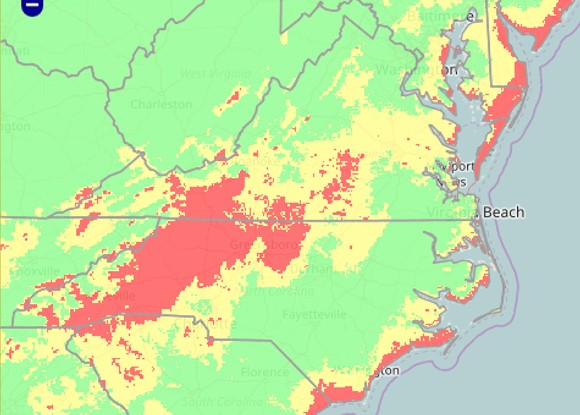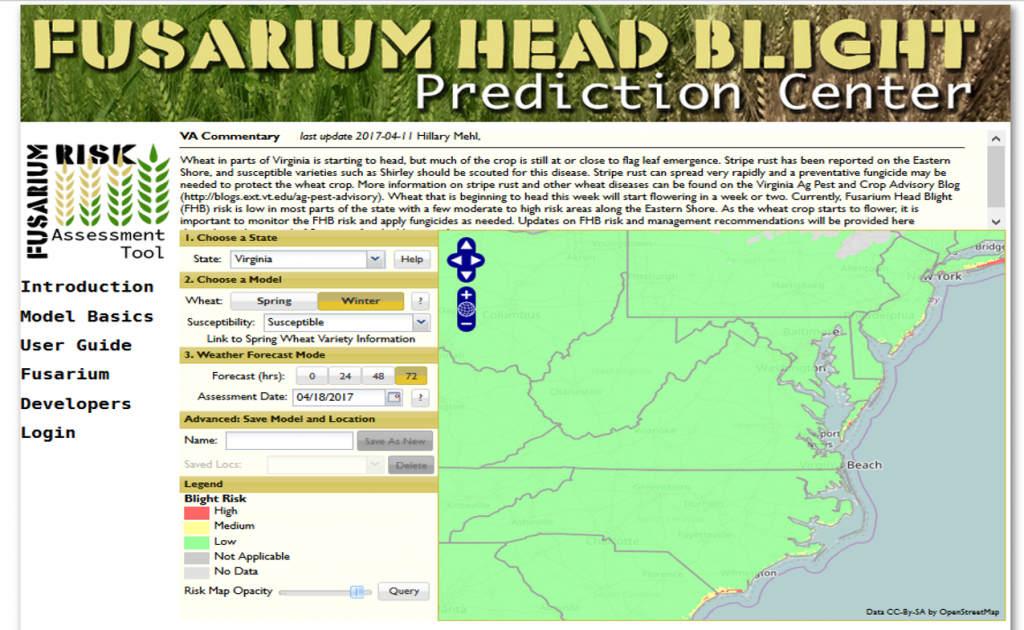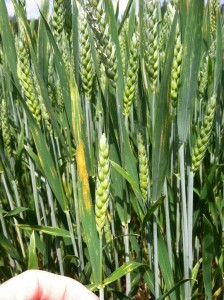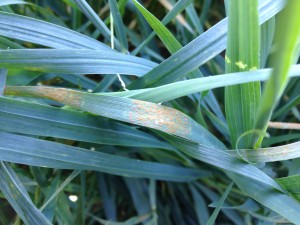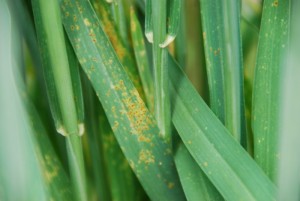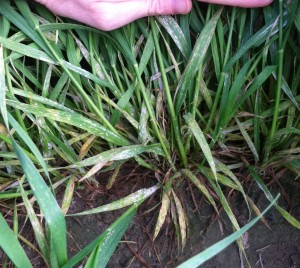Following last week’s rain, the risk for Fusarium head blight (FHB or scab) infections has increased, and the risk is very high even for moderately resistant varieties in certain portions of the state (see FHB Risk Map). Much of the wheat crop is beyond the early flowering stage, but for fields where wheat is currently flowering a fungicide may be needed to protect the crop from FHB infection and DON contamination. Recommended fungicides include Caramba, Prosaro, and Proline. Fungicides are most effective when applied at the start of flowering and up to a week later. The greatest coverage of the heads can be achieved by applying fungicides in 5 gal/A by air and 15 gal/A by ground with a 300-350 um droplet size and nozzles angled forward at least 30 degrees.
Author Archives: Hillary Mehl
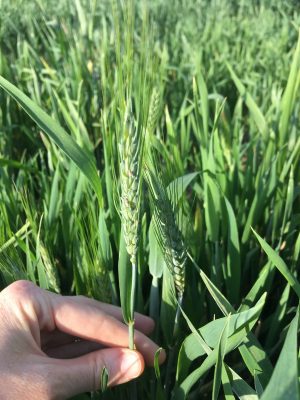
Wheat Disease Update – April 20, 2017
Wheat is beginning to flower throughout Virginia, so it is time to make decisions about fungicide applications for both Fusarium head blight (FHB, also known as scab) and to protect the flag leaf as the grains begin to form. Currently, the risk for FHB is low in most parts of Virginia, even for susceptible varieties. The FHB Risk Assessment Tool can be found at http://www.wheatscab.psu.edu. Keep in mind that this is a prediction tool and it will not predict FHB outbreaks 100% of the time. A current screen shot of the website is shown below. Rains are expected over the weekend, but dry weather over the past several weeks has not favored spore production by the FHB fungus, so risk of FHB infection is expected to remain low for wheat that is flowering over the next week. However, now may still be the time to apply fungicides for foliar diseases including stripe rust, powdery mildew, and leaf blotch. The flag leaf must be protected during grain development to maximize yields. Again, due to the dry weather some areas have very little disease, and scouting is still recommended prior to making a fungicide application. However, there have been numerous reports throughout the region of outbreaks of stripe rust (especially on Shirley) and powdery mildew. Do NOT apply a strobilurin or fungicide pre-mix containing a strobilurin after flag leaf emergence (Feekes 9) since this can increase DON contamination in the grain. Prosaro, Caramba, and Proline are the most effective products for reducing scab and DON contamination, and these fungicides will also control foliar diseases such as leaf blotch, stripe and leaf rust, and powdery mildew. A fungicide efficacy table for wheat can be found in a previous post.
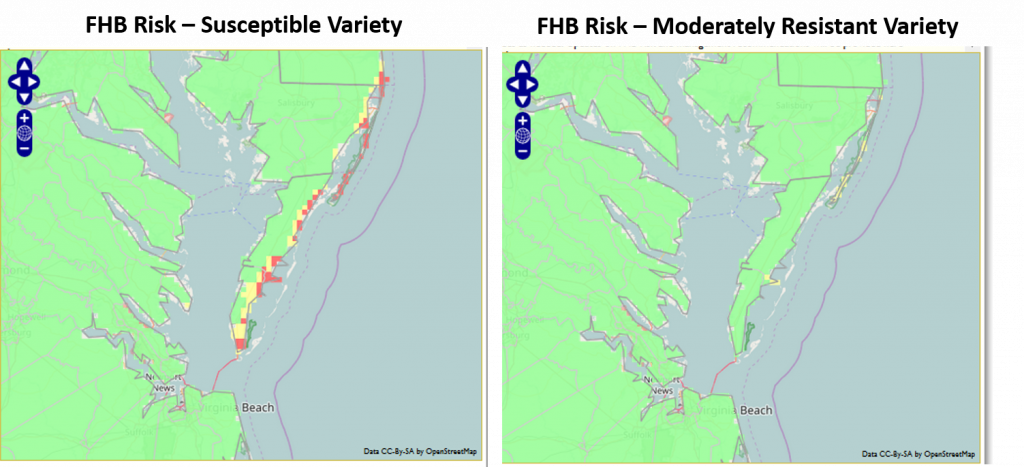 Screen shots from the Fusarium Head Blight Risk Assessment Tool (http://www.wheatscab.psu.edu) on April 20, 2017. Currently, risk of FHB infection in wheat that is flowering is low in most parts of Virginia. The exception is along the Eastern Shore where conditions are typically more humid and favorable for spore production by the FHB fungus. For susceptible varieties such as Shirley, FHB risk is moderate to high in some areas. However, for moderately resistant varieties such as Hilliard, the risk is currently low. This illustrates the importance of variety selection in management of FHB and DON contamination in wheat.
Screen shots from the Fusarium Head Blight Risk Assessment Tool (http://www.wheatscab.psu.edu) on April 20, 2017. Currently, risk of FHB infection in wheat that is flowering is low in most parts of Virginia. The exception is along the Eastern Shore where conditions are typically more humid and favorable for spore production by the FHB fungus. For susceptible varieties such as Shirley, FHB risk is moderate to high in some areas. However, for moderately resistant varieties such as Hilliard, the risk is currently low. This illustrates the importance of variety selection in management of FHB and DON contamination in wheat.
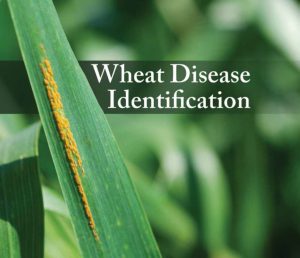
Wheat Disease Identification Guide
Copies of a Wheat Disease Identification Guide from Kansas State are now available and can be requested from Dr. Hillary Mehl at the Tidewater AREC (hlmehl@vt.edu). A PDF version of the guide can be downloaded here. Though not specific to Virginia, many of the diseases included in the guide occur in our region and detailed descriptions of symptoms and management recommendations are included. As always, if confirmation of a disease is needed for wheat or other agronomic crops, plant samples can be submitted to the Virginia Tech Tidewater AREC (6321 Holland Rd. Suffolk, VA 23437). When submitting samples, be sure to fill out the Plant Disease Diagnostic Form with as much information as possible as this will assist us with an accurate diagnosis. The form can be downloaded here: Plant Disease Diagnostic Form
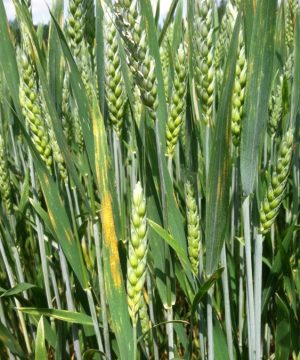
Wheat Disease Update – April 11, 2017
Though it is still a little early to be making scab fungicide applications, it is time to start thinking about if and when to apply a fungicide to the wheat crop. Wheat in parts of Virginia is starting to head, but much of the crop is still at or close to flag leaf emergence. Stripe rust was observed this week in Warsaw, VA and has been confirmed on the Eastern Shore of Virginia and in southeastern Delaware. Stripe rust is likely widespread in the state, and susceptible varieties such as Shirley should be scouted for this disease. Stripe rust can spread very rapidly and a preventative fungicide may be needed to protect the wheat crop. More information on stripe rust and other wheat diseases can be found in a previous post. Wheat that is beginning to head this week will start flowering in a week or two. Currently, Fusarium Head Blight (FHB) risk is low in most parts of the state with a few moderate to high risk areas along the Eastern Shore. As the wheat crop starts to flower, it is important to monitor the FHB risk and apply fungicides as needed. Updates on FHB risk and management recommendations will be provided here and from the FHB Alert system throughout the period of flowering for the Virginia wheat crop. You can sign up for FHB text message and/or email alerts here. Also be sure to check the FHB Risk Tool (http://www.wheatscab.psu.edu/) as the wheat crop starts to flower. If FHB risk is moderate to high, an application of a fungicide (e.g. Prosaro, Caramba) may be needed to protect the crop from scab and DON contamination. An update fungicide efficacy table for wheat can be downloaded here:
Stripe Rust Confirmed in Wheat on the Eastern Shore of Virginia
On Friday, stripe rust was confirmed on a wheat sample from a field in Northampton County, Virginia. Steve Rideout, Extension Plant Pathologist at the Eastern Shore AREC, reported that infection is fairly severe and rainy conditions will favor the pathogen’s development. This is an early sighting for this disease and constitutes a serious threat to our wheat crop. The disease was found on Shirley, which based on observations in previous years in known to be highly susceptible to stripe rut. A previous post with management recommendations including variety susceptibility ratings and a fungicide efficacy table for stripe rust and other wheat diseases can be found here:
http://blogs.ext.vt.edu/ag-pest-advisory/stripe-rust-found-in-north-carolina-wheat/
You should be scouting your wheat crop at this time, and if stripe rust is found on a susceptible variety, a fungicide application is recommended. If you have any questions or need assistance identifying diseases on your wheat crop, contact Dr. Hillary Mehl at the Tidewater AREC (hlmehl@vt.edu).
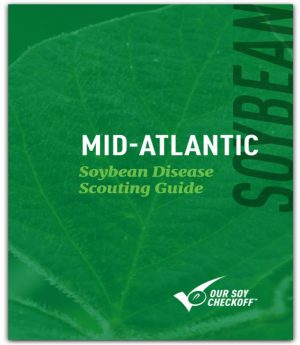
New Mid-Atlantic Soybean Disease Scouting Guide Available
A Mid-Atlantic Soybean Disease Scouting Guide was recently developed by Extension Plant Pathologists from Virginia Tech and the University of Delaware in cooperation with the state Soybean Boards and the Soybean Checkoff. An online version of the guide can be found here:
Mid-Atlantic Soybean Disease Scouting Guide
Hard copies of the guide are available at the Virginia Tech Tidewater AREC, and requests for guides can be sent to Dr. Hillary Mehl (hlmehl@vt.edu). These will also be available at grower meetings and field days in 2017.

Stripe Rust Found in North Carolina Wheat
This week, stripe rust was found in Robeson County, NC. The disease was observed in wheat variety SS 8404 which is susceptible to stripe rust. Current weather conditions (cool, wet) are generally favorable for spread and development of stripe rust, and it will likely move north into Virginia before the end of the wheat growing season. However, stripe rust is typically a problem only in susceptible varieties. With this in mind, it is important for growers to determine which of their planted varieties are susceptible to stripe rust so they will be prepared to scout and apply a fungicide once the disease makes its way to Virginia. One popular variety, Shirley, is very susceptible to stripe rust, and outbreaks of this disease were observed in some fields planted to Shirley in 2016. Stripe rust and other disease ratings for wheat in Virginia can be found in the link below for the VCE Publication Small Grains in 2016. A link to the Diseases in Small Grains chapter from the 2017 Pest Management Guide for Field Crops is also attached. This includes management recommendations and a fungicide efficacy table for stripe rusts and other diseases of wheat. Several different fungicides are available that are rated “Excellent” for stripe rust control, but fungicides are most effective when applied prior to disease development. Thus, if you know you have a variety is that is susceptible to stripe rust you should be scouting those fields and apply a fungicide if stripe rust is observed. There is no need to spray wheat for stripe rust at this time, but it is important to be aware and be prepared. If you suspect you have stripe rust, you can send a photo and/or sample to Dr. Hillary Mehl at the Tidewater AREC (hlmehl@vt.edu).
Small Grains in 2016 (variety disease susceptibility ratings)
Wheat Disease Update – May 3, 2016
Due to the recent rain, scab risk is increasing in portions of Virginia, especially on the Eastern Shore and coastal areas. The scab risk assessment tool can be found at http://www.wheatscab.psu.edu. Many fields are at or near flowering. In most areas, moderately resistant (MR) varieties are in the low to medium scab risk category, but keep in mind that many acres are still planted to moderately susceptible (MS) or susceptible (S) varieties such as Shirley. In the eastern portions of the state, scab risk is projected to be high for susceptible varieties over the next week, and it will likely be necessary to work in fungicide applications between rain events. Fungicides targeting scab should be applied within 5-6 days of flowering (50% of main tillers starting to flower from the center of the head). Do NOT apply a strobilurin or fungicide pre-mix containing a strobilurin after flag leaf emergence (Feekes 9) since this can increase DON contamination in the grain. Prosaro, Caramba, and Proline are the most effective products for reducing scab and DON contamination. These fungicides will also control foliar diseases such as leaf blotch, stripe and leaf rust, and powdery mildew. Stripe rust has been observed on susceptible wheat cultivars in some fields for several weeks now, but levels remained low due to dry conditions. The recent rain and humid conditions have resulted in spread of the disease in some areas. Similar conditions are forecasted over the next week and the disease has the potential to spread rapidly, so growers should scout their fields immediately to determine if stripe rust is present.
Wheat Disease Update – April 12, 2016
Stripe rust has been found on wheat in southeastern Virginia (Suffolk) and the Eastern Shore (Northampton County). Stripe rust is not observed every year, but it can be more aggressive than leaf rust and spread very quickly if temperatures are moderately warm and humidity/rainfall is high. Many wheat varieties are susceptible, and we do not have good stripe rust ratings for the region because the disease is fairly rare. Pictures showing typical symptoms of leaf rust and stripe rust are below. Fields should be scouted, and keep in mind it is more important to catch stripe rust early than leaf rust. If a field has good yield potential and stripe rust is present, a fungicide application is recommended. In addition to rust, powdery mildew has been reported from throughout Virginia and leaf blotch has been observed in southeastern Virginia, so as the wheat crop approaches the flag leaf emergence growth stage, it is time to start thinking about disease management. For specific fungicide recommendations, see my earlier post (April 7, 2016).
Wheat Disease Update April 7, 2016
As the wheat crop approaches the flag leaf emergence growth stage, it is time to start thinking about disease management. When conditions are conducive to disease development (e.g. high humidity, warm temperatures) foliar fungicide applications may be necessary to protect wheat yield and quality. The mild winter in 2014/2015 resulted in early onset of foliar diseases in some areas, and powdery mildew and rust were reported from a few fields as early as December. Recently, powdery mildew has been reported from throughout Virginia, leaf blotch has been observed in southeastern Virginia, and leaf and stripe rust have been reported just south of Virginia in North Carolina.
Once the flag leaf emerges, this leaf surface, which feeds the developing grain, should be protected from disease if symptoms are observed on the lower leaves and conditions are conducive to disease development. Fungicides containing a strobilurin should not be applied after heading but are a good option for control of foliar diseases as the flag leaf emerges. Late applications of strobilurins can increase DON (vomitoxin) if scab infections occur during flowering. Triazoles including Caramba, Proline, and Prosaro are good options for scab control and will also control late-season foliar disease. Currently, scab risk in the region is low but growers should consult the FHB prediction tool (http://www.wheatscab.psu.edu/) as the crop gets closer to flowering. Ideally, fungicide applications should be made based on scouting and/or risk of infection and disease development due to weather conditions. A fungicide efficacy table for many of the products registered for wheat can be found below.
2016 Wheat Fungicide Efficacy Table
As always, for more information on disease management in field crops feel free to contact Dr. Hillary Mehl, Extension Plant Pathologist by email (hlmehl@vt.edu) or phone (757-657-6450 ext. 423).

